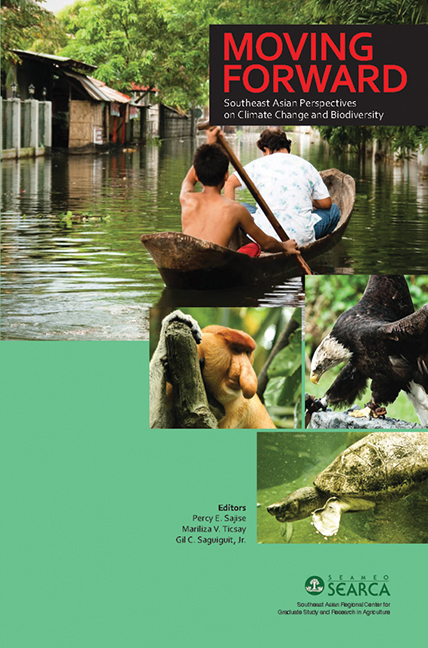Book contents
- Frontmatter
- Contents
- Tables
- Figures
- Foreword
- Preface
- Contributors
- Acronyms
- INTRODUCTION
- REGIONAL PERSPECTIVES AND CROSS-CUTTING ISSUES
- COUNTRY PERSPECTIVES
- 5 Animal Genetic Resource Conservation and Climate Change in Cambodia: Reducing Livestock to Decrease GHG Emission?
- 6 Malaysia's Current Policy and Research Initiatives Toward Climate Change: Impacts to Biodiversity
- 7 Anticipated Impacts of Climate Change on Marine Biodiversity: Using Field Situations that Simulate Climate Change in Singapore
- 8 Climate Change and Biodiversity in the Philippines: Potential Impacts and Adaptation Strategies
- 9 Research Initiatives on Climate Change Impacts and Adaptation in Thailand
- 10 The Role of Biodiversity in Climate Change Mitigation in Vietnam: The Red River Estuary - Ba Lat Case Study
- 11 Implications of the Dutch-Philippines Biodiversity Research on the Impacts, Vulnerability, and Adaptation to Climate Change: The Coastal Ecosystem
- CHALLENGES AND FUTURE ACTIONS
- Index
10 - The Role of Biodiversity in Climate Change Mitigation in Vietnam: The Red River Estuary - Ba Lat Case Study
from COUNTRY PERSPECTIVES
Published online by Cambridge University Press: 21 October 2015
- Frontmatter
- Contents
- Tables
- Figures
- Foreword
- Preface
- Contributors
- Acronyms
- INTRODUCTION
- REGIONAL PERSPECTIVES AND CROSS-CUTTING ISSUES
- COUNTRY PERSPECTIVES
- 5 Animal Genetic Resource Conservation and Climate Change in Cambodia: Reducing Livestock to Decrease GHG Emission?
- 6 Malaysia's Current Policy and Research Initiatives Toward Climate Change: Impacts to Biodiversity
- 7 Anticipated Impacts of Climate Change on Marine Biodiversity: Using Field Situations that Simulate Climate Change in Singapore
- 8 Climate Change and Biodiversity in the Philippines: Potential Impacts and Adaptation Strategies
- 9 Research Initiatives on Climate Change Impacts and Adaptation in Thailand
- 10 The Role of Biodiversity in Climate Change Mitigation in Vietnam: The Red River Estuary - Ba Lat Case Study
- 11 Implications of the Dutch-Philippines Biodiversity Research on the Impacts, Vulnerability, and Adaptation to Climate Change: The Coastal Ecosystem
- CHALLENGES AND FUTURE ACTIONS
- Index
Summary
The wetland ecosystem includes 39 types, wherein 30 are natural wetlands (11 types of coastal wetlands, and 19 types of inland wetlands) and 9 are manmade wetlands. Twenty typical marine ecosystems exist in the territorial waters of Vietnam with high biological diversity and productivity. About 11,000 species have been found in different marine ecosystems. The marine components are very rich and complex in structure, and abundant in species.
Vietnam's forest ecosystems are more diversified. The typical forest ecosystems include defoliating forests, semi-defoliating forests, and evergreen forests with high biodiversity that play important roles in the biodiversity conservation of the country.
Vietnam has a long coastline which is surrounded by mangroves from north to south. The marine areas are rich in coral reefs and seagrass beds, as well as fish. These include shrimps, lobsters, crabs, squid, mackerel, pomfret, sardines, sharks, bream, bass and marine turtles.
According to the October 2006 statistics, the Forest Management Department of the Ministry of Agriculture and Rural Development, and the Vietnam Forest Inventory and Planning Institute, the country has 30 national parks (1,041,956 ha), 60 nature reserves (1,184,372 ha), including 12 habitats/ species, and protected areas (83,480ha). There are 38 landscape/seascape protected areas (173,764 ha) with a total area of 2,400,092 ha. The 30 national parks in Vietnam occupy an estimated 2.93 per cent of the mainland area (Nguyen Huy Dung and Vu Van Dung 2007).
However, Vietnam is a young country. It is still recovering from the damage of war and the consequences of a centrally planned economy. It has a population of 86 M, of which an approximately 70 per cent live by and rely on agriculture, with rice as the main food crop. The country's two large deltas, the Red River Delta in the North and the Mekong River Delta in the South, provide fertile land for agriculture.
Since the mid-1980s, Vietnam has undergone major economic growth. The Vietnam's “Doi Moi” policy, which literally means ‘renovation’ or ‘change and newness,’ has reformed economic policy and decentralised markets.
- Type
- Chapter
- Information
- Moving ForwardSoutheast Asian Perspectives on Climate Change and Biodiversity, pp. 181 - 208Publisher: ISEAS–Yusof Ishak InstitutePrint publication year: 2010

